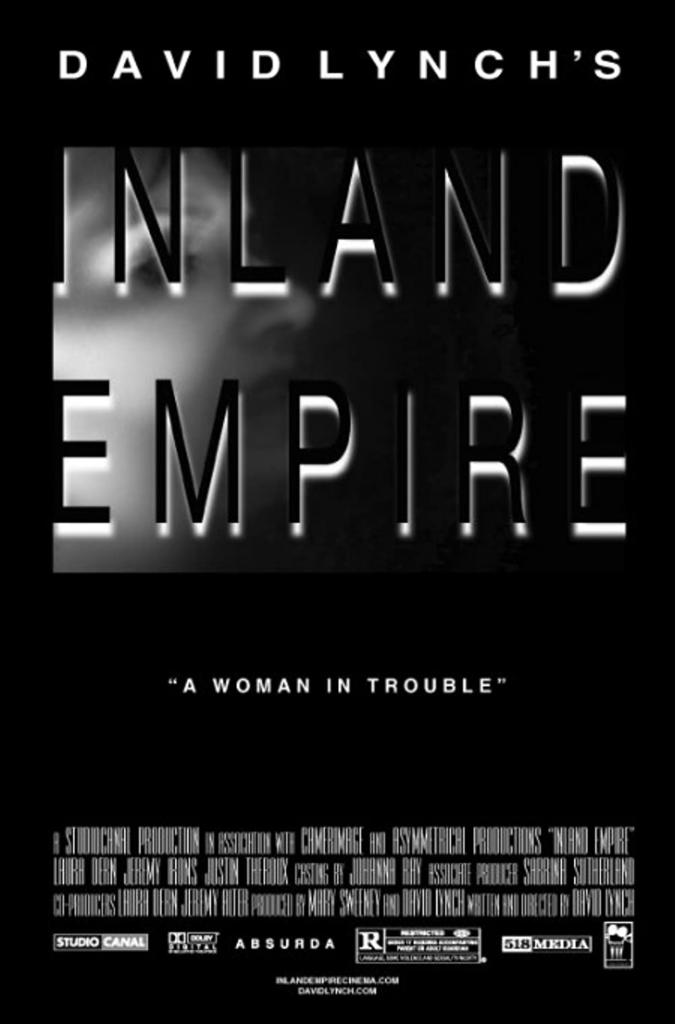
INLAND EMPIRE
(director/writer: David Lynch; screenwriters: Erik Crary/Odd Geir Saether/Ole Johan Roska; cinematographer: David Lynch; editor: David Lynch; cast: Laura Dern (Nikki Grace/Susan Blue), Jeremy Irons (Kingsley Stewart), Justin Theroux (Devon Berk/Billy Side), Grace Zabriskie (Visitor No. 1), Julia Ormond (Doris Side), Harry Dean Stanton (Freddie Howard), Diane Ladd (TV hostess); Runtime: 179; MPAA Rating: R; producer: David Lynch/Mary Sweeney; Studio Canal; 2006)
“It’s a movie spent inside Lynch’s complicated head.”
Reviewed by Dennis Schwartz
Maverick filmmaker David Lynch’s (“Eraserhead”/”The Elephant Man”/”Blue Velvet”) most ambitious experimental film to date, which is saying a mouthful, is a mind-bending trip that belies coherence and demands at least our attention if we consider ourselves to be serious viewers of film; if ever there was a noncommercial film this one is it. It’s a movie spent inside Lynch’s complicated head, which is a heckuva place for an art film to be located.
It’s Lynch’s first film in five years and first in digital video (shot on an outdated and cheapie handheld Sony PD150 digital video recorder). The filmmaker insists that its title be spelled out in all capitalized letters, and in an interview says he shot it on the sly for a year without a final screenplay. It’s a difficult film to come to terms with on just one sitting because its plot is illogical, following along the lines of a dream, and I believe demands for most of us further viewings before even becoming watchable. In this film we go from the Lodz ghetto in Poland to the false glitter of Hollywood Boulevard, and things somehow strangely mesh together in the same nonlinear patterns as an avant-garde Maya Deren film. Such incoherence can be surprisingly effective if the viewer has an open mind and sticks with it despite the obvious difficulties of getting with the program. Its deterrents are its demanding length of three hours, how unfocused and confusing it is, and that the surreal narrative never quite settles into being like other films leaving us left in the dark without too many clues exactly where Lynch is going with this one (I’m not even sure he knows, as he seems juiced up by his intuitive responses). The plusses are in its originality, stunning dreamlike quality, its intriguing poke around a highly personal subject matter that honestly tells us where the filmmaker is at in creating his art, its seductive meditative inducing nature, its strong political stance revealing Lynch’s love/hate affair with Hollywood and how hurt he was that the industry did not give him final cut over his films (a reason for this independently produced film), and the stellar performance by Laura Dern, wisely featured in almost every scene, that is able to keep things grounded on a human level even as she blurs reality with illusion.
Dern is wealthy actress Nikki Grace starring in a new romantic movie about adultery down south, in a juicy role she coveted, directed by the eager-beaver unctuous director Kingsley (Jeremy Irons) and co-starring opposite the supposedly awful womanizer, Devon (Justin Theroux), according to the nasty gossip of an insider TV hostess (Diane Ladd, Dern’s real mother). Nikki’s intense new Eastern European accented neighbor (Grace Zabriskie), whom she meets for the first time, visits her haunting Hollywood mansion and warns her not to take the role because it’s fraught with dangers. From the director assistant (Harry Dean Stanton) Nikki learns the screenplay is based on a gypsy curse and was shot before in Poland but never released because the original lead stars were savagely murdered.
That’s the normal part of the film, the weird part follows as Nikki loses track of who she is and can’t distinguish herself from the character, Susan Blue, she plays in the movie-within-the-movie called On High in Blue Tomorrows. Nikki also shows up as a physically abused but unafraid to speak her mind working-class housewife and as a tawdry hooker whose territory is on Hollywood Boulevard and who spits out blood that finds its way over some of the stars on the Walk of Fame (the film’s most powerful statement about Hollywood and how it can kill the artist by making him a whore as it takes away his freedom).
The script inevitably has art and life merging (following along the lines that truth is stranger than fiction), as adultery plays out on both ends. Furthermore there’s a sitcomlike family sitting around a TV set dressed like giant humanoid rabbits (voiced by Naomi Watts, Laura Harring and Scott Coffey), hookers who sing “The Loco-Motion.” From there-on the film is an hallucinatory adventure that defies logic or the usual cinematic tribulations, as it both vouchsafes the power of images and confirms that Hollywood is a place haunted by its ghosts. It’s a film to puzzle over and to care about how well-crafted, intense, sincere and digging it is in its free-form approach, and not a film that has to be necessarily enjoyed or compared with other Hollywood films or to be fully understood for it to be appreciated.
It also pays to stay around for the final credits, as an animated music video staged around Nina Simone’s Sinnerman is presented.
REVIEWED ON 11/13/2007 GRADE: A